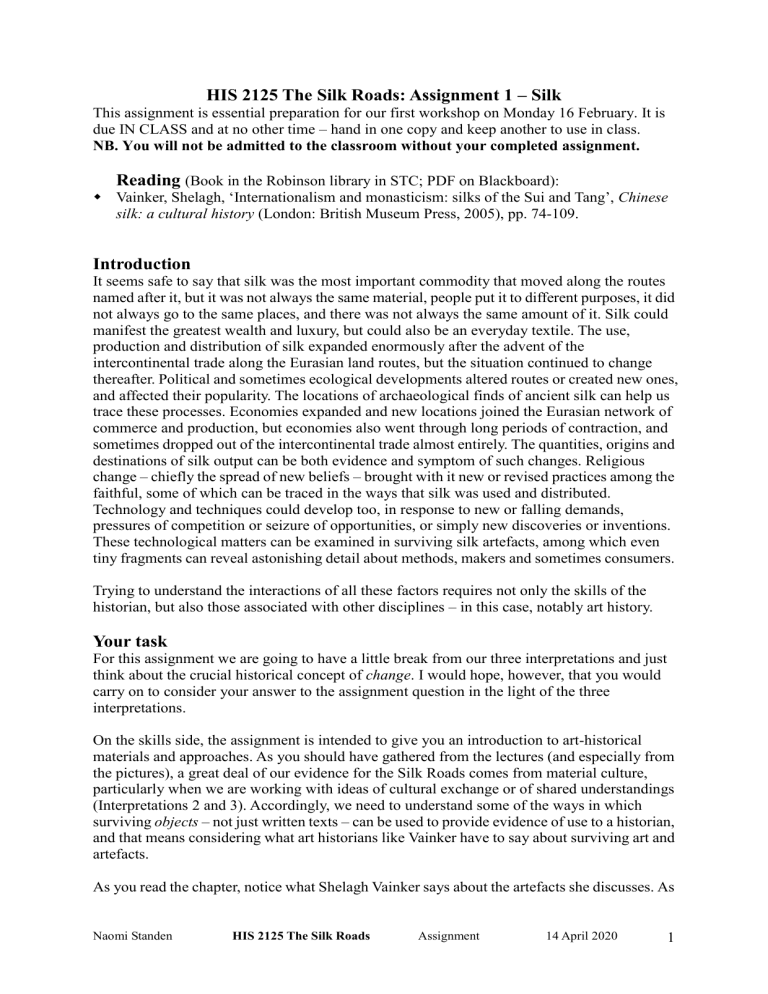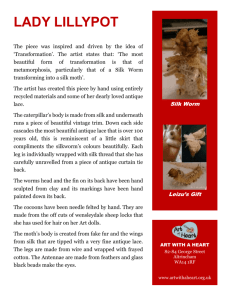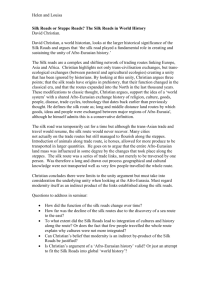Silk - Artsweb

HIS 2125 The Silk Roads: Assignment 1 – Silk
This assignment is essential preparation for our first workshop on Monday 16 February. It is due IN CLASS and at no other time – hand in one copy and keep another to use in class.
NB. You will not be admitted to the classroom without your completed assignment.
Reading
(Book in the Robinson library in STC; PDF on Blackboard):
Vainker, Shelagh, ‘Internationalism and monasticism: silks of the Sui and Tang’, Chinese silk: a cultural history (London: British Museum Press, 2005), pp. 74-109.
Introduction
It seems safe to say that silk was the most important commodity that moved along the routes named after it, but it was not always the same material, people put it to different purposes, it did not always go to the same places, and there was not always the same amount of it. Silk could manifest the greatest wealth and luxury, but could also be an everyday textile. The use, production and distribution of silk expanded enormously after the advent of the intercontinental trade along the Eurasian land routes, but the situation continued to change thereafter. Political and sometimes ecological developments altered routes or created new ones, and affected their popularity. The locations of archaeological finds of ancient silk can help us trace these processes. Economies expanded and new locations joined the Eurasian network of commerce and production, but economies also went through long periods of contraction, and sometimes dropped out of the intercontinental trade almost entirely. The quantities, origins and destinations of silk output can be both evidence and symptom of such changes. Religious change – chiefly the spread of new beliefs – brought with it new or revised practices among the faithful, some of which can be traced in the ways that silk was used and distributed.
Technology and techniques could develop too, in response to new or falling demands, pressures of competition or seizure of opportunities, or simply new discoveries or inventions.
These technological matters can be examined in surviving silk artefacts, among which even tiny fragments can reveal astonishing detail about methods, makers and sometimes consumers.
Trying to understand the interactions of all these factors requires not only the skills of the historian, but also those associated with other disciplines – in this case, notably art history.
Your task
For this assignment we are going to have a little break from our three interpretations and just think about the crucial historical concept of change . I would hope, however, that you would carry on to consider your answer to the assignment question in the light of the three interpretations.
On the skills side, the assignment is intended to give you an introduction to art-historical materials and approaches. As you should have gathered from the lectures (and especially from the pictures), a great deal of our evidence for the Silk Roads comes from material culture, particularly when we are working with ideas of cultural exchange or of shared understandings
(Interpretations 2 and 3). Accordingly, we need to understand some of the ways in which surviving objects – not just written texts – can be used to provide evidence of use to a historian, and that means considering what art historians like Vainker have to say about surviving art and artefacts.
As you read the chapter, notice what Shelagh Vainker says about the artefacts she discusses. As
Naomi Standen HIS 2125 The Silk Roads Assignment 14 April 2020 1
you do this, it is very important that you look at the pictures . Try to see, in detail, what she describes. You will find on Blackboard not only Vainker’s article but also her glossary and a page of illustrations of different types of weave. These should assist you in understanding the technicalities of what she is talking about. You should also think about why such technicalities are important. What do they tell us about what was being produced, why it was being produced, who was producing it, and the social, political, economic, religious, ideological, and other constraints and opportunities that contributed to its production? These are not questions I want you to answer directly in the assignment, but you will find that your answer – and your future study – will benefit from thinking about them as you read. I hope you have noticed that these questions about material culture – no written evidence involved – are identical to the questions that a historian would ask about a textual primary source.
How to do it
1.
Read the chapter carefully, and study the pictures. Think about the ways in which what you learn from this chapter fits (or not) with what you have learned so far.
2.
On a separate sheet, and in one short paragraph (no more than 250 words or one side of A4, double-spaced), answer this question:
What was the most important change in the production, use or distribution of silk in Tang China?
Be sure to support what you have to say with evidence (specific examples) from the reading.
Do not also attempt to answer any of the other questions on this sheet, which are there simply to help you with your thinking.
3.
IMPORTANT: Do not attempt to write a mini-essay – you do not have enough words!
Write one good paragraph: it should have a point, and that point should be supported with evidence – that is, with specific examples . That’s it.
Note that you are likely to come up with more than one reason – pick the one you think is most important , and make the best case you can for that one reason.
Note also that you have a choice of production, use or distribution. Of the three processes, which one(s) saw the most important change?
4.
Copy your answer sheet. One copy is your ticket’ to get into the Workshop; the other is for you to work on in class. Remember: you will not be admitted to the classroom without your completed assignment .
If you have any problems or questions, please get in touch with me in my office or (more reliably) by e-mail.
Naomi Standen HIS 2125 The Silk Roads Assignment 14 April 2020 2










